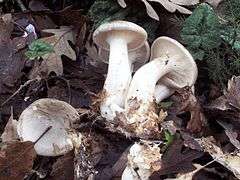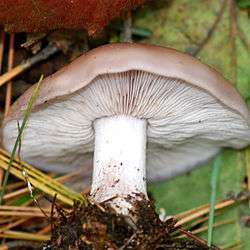Clitocybe
| Clitocybe | |
|---|---|
 | |
| Clitocybe nebularis | |
| Scientific classification | |
| Kingdom: | Fungi |
| Division: | Basidiomycota |
| Class: | Agaricomycetes |
| Order: | Agaricales |
| Family: | Tricholomataceae |
| Genus: | Clitocybe (Fr.) Staude (1857)[1] |
| Type species | |
| Clitocybe nebularis (Batsch) P.Kumm. (1871) | |
| Synonyms[2] | |
Clitocybe is a genus of mushrooms characterized by white, off-white, buff, cream, pink, or light-yellow spores, gills running down the stem, and pale white to brown or lilac coloration. They are primarily saprotrophic, decomposing forest ground litter. There are estimated to be around 300 species in the widespread genus.[3]
Clitocybe means sloping head.
A few members of the genus are considered edible; many others are poisonous, containing the toxin muscarine among others. Distinguishing individual species of Clitocybe is generally prohibitively difficult to non-experts, requiring the analysis of microscopic characters. Therefore, with the exception of a few charismatic and readily identified members, Clitocybe mushrooms are rarely collected for consumption.
Taxonomy
Clitocybe was originally proposed by Elias Fries in 1821 as a tribe in the genus Agaricus. Friedrich Staude elevated it to generic status in 1857.
Recent molecular work has shown the genus to be polyphyletic, with many members seemingly distantly related and other fungi, such as the field blewit and wood blewit, now known as Clitocybe saeva and C. nuda respectively, are more closely related. As C. nebularis is the type species,[4] those most distantly related to it would be likely to be reclassified in the future.
In a 2003 paper, Finnish mycologist Harri Harmaja proposed C. geotropa and twelve other Clitocybe species be split off into a new genus Infundibulicybe on the basis of spore properties. He also reclassified C. clavipes in the genus Ampulloclitocybe, that genus name taking precedence over his own proposal Clavicybe.[5] Other former Clitocybe species have been placed in the genera Atractosporocybe, Leucocybe and Rhizocybe.[6]
Toxicity
The consumption of two species, Clitocybe acromelalga from Japan,[7] and Clitocybe amoenolens from France,[8] has led to several cases of mushroom-induced erythromelalgia which lasted from 8 days to 5 months.[9]

Many small Clitocybe species contain the toxin muscarine, which was originally found in small amounts in the famous fly agaric. However, the small white Clitocybe species contain muscarine in dangerous amounts, and two species in particular, the closely related Clitocybe dealbata and Clitocybe rivolusa, contain muscarine in deadly amounts, and deaths have been recorded for eating those two Clitocybe species.
Selected species
- Clitocybe acromelalga (Japan)
- Clitocybe agrestis
- Clitocybe alexandri
- Clitocybe amarescens
- Clitocybe amoenolens – poisonous bamboo mushroom (France)
- Clitocybe brumalis – winter funnel cap
- Clitocybe candicans
- Clitocybe candida
- Clitocybe cerussata
- Clitocybe cistophila – Europe
- Clitocybe clavipes – may be edible but poisonous when consumed in conjunction with alcohol
- Clitocybe dealbata – ivory funnel, sweating mushroom (Europe), poisonous
- Clitocybe ditopus
- Clitocybe dilata
- Clitocybe eccentrica
- Clitocybe entoloma
- Clitocybe eucalyptorum
- Clitocybe fennica
- Clitocybe fragrans ' – fragrant funnel
- Clitocybe geotropa – trooping funnel, monk's head agaric
- Clitocybe glacialis
- Clitocybe globispora
- Clitocybe glutiniceps
- Clitocybe lohjaensis
- Clitocybe marginella
- Clitocybe maxima
- Clitocybe menthiodora
- Clitocybe nebularis – clouded agaric – considered edible by some, though causes gastric upset in many people
- Clitocybe nuda – wood blewit – a common edible distinguished in part by its lilac hue
- Clitocybe odora – aniseed toadstool; grows near birch trees, but can be easily mistaken for poisonous ones mainly because of its appearance
- Clitocybe paraditopa – Australia
- Clitocybe parasitica
- Clitocybe rivulosa – fool's funnel (Europe, North America)
- Clitocybe ruderalis
- Clitocybe sclerotoidea
- Clitocybe strigosa
- Clitocybe subcordispora
- Clitocybe truncicola
- Clitocybe vibecina
The bioluminescent jack o'lantern mushroom (Omphalotus olearius) was formerly placed in this genus as Clitocybe illudens.
Pharmacology
An extract of Clitocybe gibba exhibits inhibitory activity on thrombin.[10]
See also
References
- ↑ Staude F. (1857). Die Schwämme Mitteldeutschlands, in besondere des Herzogthums (in German). pp. 1–150.
- ↑ "Synonymy: Clitocybe (Fr.) Staude". Species Fungorum. CAB International. Retrieved 2015-03-24.
- ↑ Kirk PM, Cannon PF, Minter DW, Stalpers JA (2008). Dictionary of the Fungi (10th ed.). Wallingford, UK: CABI. p. 152. ISBN 978-0-85199-826-8.
- ↑ Redhead, S.A.; et al. (2002a). "Phylogeny of agarics: partial systematics solutions for core omphalinoid genera in the Agaricales (euagarics)". Mycotaxon. 83: 19–57.
- ↑ Harmaja, Harri (2003). "Notes on Clitocybe s. lato (Agaricales)" (PDF). Annales Botanici Fennici. 40: 213–18.
- ↑ Alvarado P, Moreno G, Vizzini A, Consiglio G, Manjón JL, Setti L (2015). "Atractosporocybe, Leucocybe and Rhizocybe, three new clitocyboid genera in the Tricholomatoid clade (Agaricales) with notes on Clitocybe and Lepista". Mycologia. 107 (1): 123–36. doi:10.3852/13-369. PMID 25344261. Retrieved 2015-03-01.
- ↑ Ichimura, J (1918). "A new poisonous mushroom". Bot Gaz (Tokyo). 65: 10911.
- ↑ Saviuc PF, Danel VC, Moreau PA, Guez DR, Claustre AM, Carpentier PH, Mallaret MP, Ducluzeau R (2001). "Erythromelalgia and mushroom poisoning". J. Toxicol Clin Toxicol. 39 (4): 403–07. doi:10.1081/CLT-100105162.
- ↑ Diaz, James H. (2005). "Syndromic diagnosis and management of confirmed mushroom poisonings". Critical Care Medicine. 33 (2): 427–36. doi:10.1097/01.CCM.0000153531.69448.49. PMID 15699849.
- ↑ Doljak, B.; Stegnar, M.; Urleb, U.; Kreft, S.; Umek, A.; Ciglarič, M.; Štrukelj, B.; Popovič, T. (2001). "Screening for selective thrombin inhibitors in mushrooms". Blood Coagulation and Fibrinolysis. 12 (2): 123–8. doi:10.1097/00001721-200103000-00006. PMID 11302474.
External links
| Wikimedia Commons has media related to Clitocybe. |